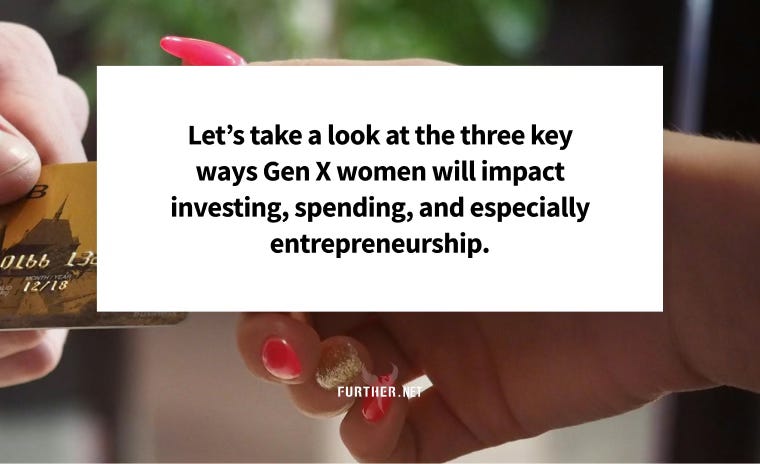Rise of the Matriarchy: Why Gen X Women Will Take the Lead
The implications of a shift toward more power for midlife women are fairly profound.
Join 19,000+ people looking to live their best life at midlife by grabbing our free resource: The Further Guide to Unretirement Planning. Or upgrade to Further Premium for the full experience.
Are you ready to serve the most powerful economic group on the planet with your new business?
No, it’s not Millennials or Gen Z. Our marketing obsession with youth may go down kicking and screaming, but cold hard logic (not to mention cash) says things are about to shift in a big way to the other end of the spectrum.
We’re talking about the group of people currently over the age of 50. This is already the cohort with the most spending power, and that will only increase over the years to come.
People aged fifty and over already account for more than half of consumer spending in the United States and 83% of household wealth, with both numbers expected to increase significantly.
Within a decade, the largest economic group will be the population above age sixty, giving rise to the “gray market” — the largest consumer bloc of all. If you’re looking for a market segment to serve as a midlife entrepreneur, this is it.
But odds are you won’t be communicating with just any older consumer. You’ll be attempting to convince an older female consumer.
The implications of a shift toward more power for midlife women are fairly profound. Let’s take a look at the three key ways our own influential Gen X ladies will take the lead and impact investing, spending, and especially entrepreneurship.
Women Will Control More Wealth Overall
Historically, it’s been men who have generated, owned, and managed wealth. This is coming to an end, according to Wharton School professor Mauro F. Guillén.
That’s because women are gaining wealth faster than men, to the point that by 2030, women will own more than half the world’s total wealth. Guillén explores the ramifications of this shift in his book 2030: How Today’s Biggest Trends Will Collide and Reshape the Future of Everything:
These momentous trends spell massive changes not just for society but also for capital markets, because women are different from men when it comes to investing; for companies, because women bring different perspectives to the workplace; and for innovation, because women are increasingly becoming entrepreneurs.
There are many logical reasons why this is happening. For example, Guillén shares that women receive the majority of undergraduate and graduate degrees in the United States, and more than 40 percent of women earn more than their husbands.
Then there’s the fact that women tend to live longer than men. When you think about the vast resources of the Baby Boomer generation, it stands to reason that married women will take control of much of that wealth, given that their husbands or partners will pass years before they do.
As we move forward, that increased life expectancy combined with the greater emphasis that women tend to place on preserving healthspan will lead to longer work lives. This will only accelerate the longevity flywheel of consumer spending by older women.
To this point, Joseph Coughlin, director of the MIT AgeLab and author of The Longevity Economy: Inside the World's Fastest Growing, Most Misunderstood Market, believes that women are less likely to buy into the “retirement dream” than men typically do:
There are a few probable explanations for why women are leading the charge toward work in old age. One may be that they seem to internalize less indoctrination regarding the stage of life we’ve been taught to call “retirement.”
Whether or not a woman continues working for longer, she is still the primary prospect from a marketing standpoint. That’s because women make the bulk of consumer-spending decisions regardless of other factors.
50+ Women are Super Consumers
It’s no secret that advertisers and marketers tend to ignore people over the age of 50 thanks to a misguided obsession with youth. That’s a shame, because while the kids are struggling, older women control a vast amount of spending power:
Women over 50 account for 27 percent of all consumer spending — that’s 3 percent more than men of that age. Forbes has called women over 50 super consumers," because, with over $15 trillion in purchasing power, they are the healthiest, wealthiest, and most active generation in history.
The disparity in who makes purchasing decisions between women and men is likely more pronounced than that statistic suggests. As Coughlin puts it:
If anything, the real question is not which purchasing decisions older women make but which are left for their husbands — to the extent that their husbands are even alive.
Then there’s the unfair fact that when it comes to eldercare, it’s usually a woman doing the caretaking. When one spouse cares for the other in a heterosexual relationship, it’s usually the woman caring for the man. In the case of an adult child providing care to an older parent, that child is usually a daughter.
In both cases, a woman will be the one making all the purchasing decisions within the longevity economy. Marketers and entrepreneurs must take note and craft messaging accordingly.
Women also spend money differently from men. Guillén notes that women purchase education, healthcare, and insurance more readily, not just for themselves but for their children and grandchildren as well.
So is the fast increase in women’s wealth accumulation leading to a large transformation of the economy? Absolutely. Remember that spending on education, healthcare, and insurance accounts for about 30 percent of the American economy. As women accumulate more wealth over the next decade, those parts of the economy will benefit from increased spending.
Perhaps most importantly, according to Coughlin, we’ll look to older women consumers for key indicators when developing new products and services:
When consumers vote with their pocketbooks against the current narrative, it will be women who lead the way. Across age groups, they have a better idea than their male counterparts of which issues they will want solved in later life. They will be the first to recognize where existing solutions are inadequate or address the wrong questions. They will know the difference between products that attempt to solve the problem of older adults and those that solve problems for older adults.
As if women controlling the money and the ultimate call on how it’s spent wasn’t enough to convince you, there’s more. Women will also be starting businesses and creating innovative products and services, and this is where Generation X has an unfair advantage.
Gen X Women Will Drive Change as Entrepreneurs
In his book, Professor Guillén projects that nearly half of all new business ventures will be launched by women by 2030. And based on what we know about the realities of starting businesses, most of those who succeed will be over 50.
Despite the media narrative that entrepreneurship is a “young man’s” game, research shows otherwise. Generation X is already the most entrepreneurial cohort, and recent research shows we’re at the age when most successful businesses are started, which is between 45 and 65.
And now it will be Gen X women who lead the entrepreneurial charge, perhaps by serving the lucrative market of older women who are super consumers. While they are by no means limited to this market, it makes a lot of sense for people who inherently understand what problems to solve for this valuable demographic.
It may well be that 50+ women grow impatient with largely young, male product designers and take things into their own hands. Rather than simply providing indications of what new products and services are needed by older women, Gen X women will create those offerings along with the businesses that promote them.
The misconceptions and stereotypes associated with aging can be barriers to success for older entrepreneurs. But it’s also true that those at middle age can see clearly what’s required when others can’t. Coughlin sums up what’s needed:
For anyone in the business of selling anything to the older, mostly female demographic, the challenge … is one of imagination: whether companies can grasp the true needs of their consumers as the consumers themselves experience them.
Barriers still need to fall, though.
Despite higher success rates, older entrepreneurs have a harder time raising capital. Plus, add to that the challenge women face with investors. And the diminution of women’s rights in the United States demonstrates that there’s clearly work to be done to remove unnecessary barriers.
Fortunately, there will be plentiful opportunities for bootstrapped businesses that will fill vital roles in the longevity economy. And that’s where the Personal Enterprise approach comes in.
Keep going-
P.S. You can now earn access to Further Premium by recommending Further to friends! Subscribers, get your unique referral link here.
further: flashback
🎶 The Escape Club - Wild Wild West, Wild Wild West, 1988 🎶
The Escape Club topped the U.S. charts in 1988 with Wild Wild West, which is an obvious rip off homage to Pump It Up by Elvis Costello, which in turn was heavily inspired by Bob Dylan's Subterranean Homesick Blues, the video concept for which was directly lifted by INXS for Mediate. It's not exactly clear who U2 was ripping off with Get On Your Boots, but it's essentially the same song as Wild Wild West. (YouTube)
further: sharing
Enjoy this issue? Please forward this email to friends or share by clicking below:
Thank you for sharing Further!




Yes! As a badass Gen X woman who chose slow travel and early retirement over the grind, I’ve built a life around my love language: quality time. I don’t have a ton of extra cash, but I’ve got freedom, clarity, and the guts to live on my own terms.
If entrepreneurship means rewriting the rules and leading with intention, then count us in. We’re not just driving change… We are the shift.
Super interesting. I’m a young Gen X woman in the process of reinvention and this was very encouraging. Thanks!